For tabletop rearrangement problems with overhand grasps, storage space outside the tabletop workspace, or buffers, can temporarily hold objects which greatly facilitates the resolution of a given rearrangement task. This brings forth the natural question of how many running buffers are required so that certain classes of tabletop rearrangement problems are feasible. In this work, we examine the problem for both the labeled (where each object has a specific goal pose) and the unlabeled (where goal poses of objects are interchangeable) settings. On the structural side, we observe that finding the minimum number of running buffers (MRB) can be carried out on a dependency graph abstracted from a problem instance, and show that computing MRB on dependency graphs is NP-hard. We then prove that under both labeled and unlabeled settings, even for uniform cylindrical objects, the number of required running buffers may grow unbounded as the number of objects to be rearranged increases; we further show that the bound for the unlabeled case is tight. On the algorithmic side, we develop highly effective algorithms for finding MRB for both labeled and unlabeled tabletop rearrangement problems, scalable to over a hundred objects under very high object density. Employing these algorithms, empirical evaluations show that random labeled and unlabeled instances, which more closely mimics real-world setups, have much smaller MRBs.
翻译:对于使用过手抓的桌面重新排列问题,在桌面工作空间外的存储空间或缓冲层,可以暂时搁置非常有助于解决特定重新排列任务的对象。 这就提出了一个自然的问题, 需要多少个运行缓冲, 以便某些类型的桌面重新排列问题是可行的。 在这项工作中, 我们检查标签下( 每个对象都有特定目标构成) 和未标签下( 对象的目标构成是可互换的) 设置的问题。 在结构方面, 我们观察到, 找到运行缓冲( MRB) 的最小数量可以用一个从问题实例中提取的依附图进行, 并显示在依赖图形上计算 MRB 是硬的。 我们然后证明, 在标签下和非标签下设置的两种环境下, 需要运行缓冲的数量可能会随着要重新排列的天体数目的增加而变得无限制。 我们进一步显示, 未标的外壳的绑紧。 在算式侧面, 我们开发了非常高效的任意的算法, 来找到 mRB 高标签上和未标上 的 高额的 。





